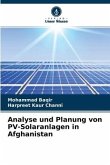Nowadays Afghanistan is facing a challenging energy situation, the electricity consumption to the national grid is imported from neighboring countries, such as Iran, Uzbekistan, Tajikistan and Turkmenistan. This country is annually paying 280million dollar to the neighboring countries for importing 670MW. Nevertheless the country is still facing shortage of electricity in rural area. To overcome these issues, the government of Afghanistan is planning to generate 5,000MW of renewable energy by 2032, among them the share of solar projects should be 1,500MW. 30 percent of electricity demand in 2032 will be met by solar energy, according to the Afghanistan Renewable Energy Union (AREU).The Daykundi province is located in the center of Afghanistan. Which is having great sunlight to generate solar energy. As I have tested on Pvsyst software, the designing of 700KWp. In which the system production is 1266MWh/yr. the performance ratio is 0.797. Solar energy technology is increasingly suggested for power production when the PF is between 0.7 and 0.9. Pvsyst was used to simulate 700KWp grid-connected solar power plant in Afghanistan's Daikundi regionand all of its performances were assessed.








